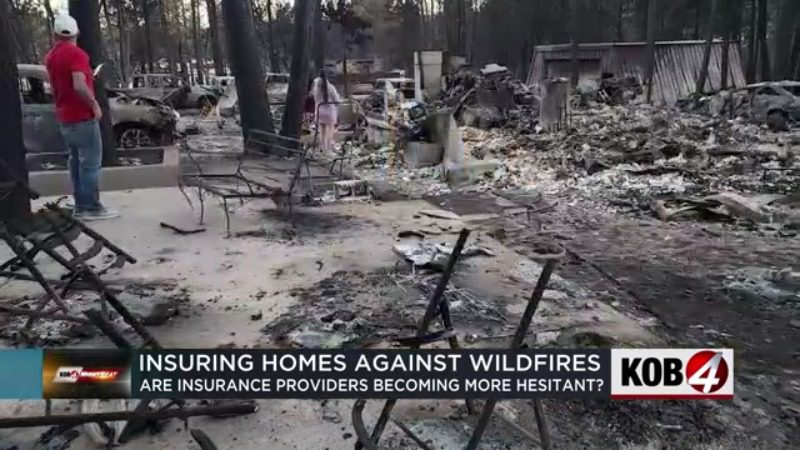State Farm hesitant to insure northern New Mexico homes
ALBUQUERQUE, N.M. – It’s becoming more difficult to insure your home or business against wildfires in New Mexico – that’s according to some local insurance agents.
“We’ve had a lot of larger residential houses where we’re not able to find them an option at all,” said Jake Boles, an Alamogordo-based insurance agent and board chair for Independent Insurance Agents of New Mexico.
Boles says he noticed some insurance providers becoming more hesitant shortly before the McBride Fire started near Ruidoso in April 2022. He says some providers decided not to renew their coverage for nearby commercial businesses three months before the fire because of wildfire risk.
Boles says it’s a trend becoming more common in communities near Ruidoso, Silver City and northern New Mexico.
“It’s increased exponentially, this company saying ‘we’re not writing insurance in this huge area,’ which could be like the Sacramento mountains, or the northern mountains in northern New Mexico,” he said. “They’re just not willing to do business there.”

It’s a growing concern for communities all across the western United States.
On Friday, State Farm announced it will no longer accept new property insurance applications for homes or businesses in California.
Company officials cited “historic increases in construction costs outpacing inflation, rapidly growing catastrophe exposure, and a challenging reinsurance market” in a statement.
The company says coverage for existing customers will not be affected.
“I think all the western states are under similar pressures from the increase in wildfires and the destruction of them.,” said Janet Ruiz with the Insurance Information Institute. “The insurance industry has lost all its underwriting profit for 20 years in the last six years, and that is due to the unprecedented losses that we have experienced in California from wildfires.”
Ruiz estimates more than 25,000 homes were destroyed across California in just the past six years. It’s not clear how much money insurance companies paid out to homeowners, but U.S. Census data estimates the value of homes directly exposed to wildfires in California is around $343 billion.
Ruiz admits the situation in California is unique. She says new and existing wildfire insurance protections in the state have artificially lowered premiums for customers while also increasing the amount of insurance payouts. She says California homeowners are paying roughly $1,300 for property insurance while homeowners in Florida – a state also prone to natural disasters – are paying close to $4,000.
“In states where they’re able to collect adequate premium and manage the risks appropriately, [insurance providers] don’t have to take the underwriting measures of shrinking their book of business, or possibly not writing new business,” Ruiz said. “I think at this particular point in time, California has some issues that some other western states aren’t having quite as severely.”
Patty Padon, the executive director of Independent Insurance Agents of New Mexico, says State Farm’s announcement is frightening.
“To see them pull out of a state due to the reinsurance problems, and to the increased cost of a construction – that scares me,” she said. “Because it can trickle down to our state, and we’re a much smaller state.”
Padon suggests issues reinsurance companies are a driving force behind dwindling wildfire insurance protections. Reinsurance companies are essentially insurance companies for insurance providers – they provide financial protection for companies like State Farm. Padon suggests those companies hold a lot of influence over traditional insurance providers.
“When a reinsurance carrier raises their rates, or says ‘we no longer want to do business in a state or in an area where there’s wildfires,’ then [insurance providers] have no choice but to either raise their rates as well, or to not write those risks up,” she said.
Padon and Boles both believe a recent increase in satellite mapping data is fueling hesitations from insurance providers.
“For many years, they’ve looked at how far a property is from a fire station,” Boles said. “Over time, they use more and more data and said ‘we’re going to use a brush fire score.”
Padon says those scores are based on the amount of brush near certain properties shown in satellite maps. She argues those maps often don’t accurately reflect an area’s true wildfire risk.
“With Ruidoso, they’ve worked very hard as a city to clean up,” she said. “They make every resident clean within 500 feet of their dwelling and get rid of dead trees. They’ve done really well with all the mitigation, and nobody sees that in a satellite map.”
Despite their concerns with the methodology, both Padon and Boles seem to understand the economic situation insurance providers are facing.
“An insurance company has a pot of money, and they’re going to sell X amount of insurance and then their claim their losses,” Padon said. “They don’t care if it was in Texas, California, Florida, they look at their total loss ratio and go ‘we got to cut somewhere.”
Padon worries about a potential domino effect. She says insurance providers will typically follow after each other when it comes to deciding what situations to cover.
“If several in New Mexico are starting to close off business, you’ll start eventually, it’ll trickle down, and you’ll see others do it,” she said.
Padon and Boles believe it’s time for New Mexico’s state lawmakers to start brainstorming potential solutions – Padon suggests a state fund to cover wildfire insurance premiums.
Both said it is too early for most New Mexican homeowners to be worried about their insurance. Boles says they’ll have a better understanding of the situation in about a year.